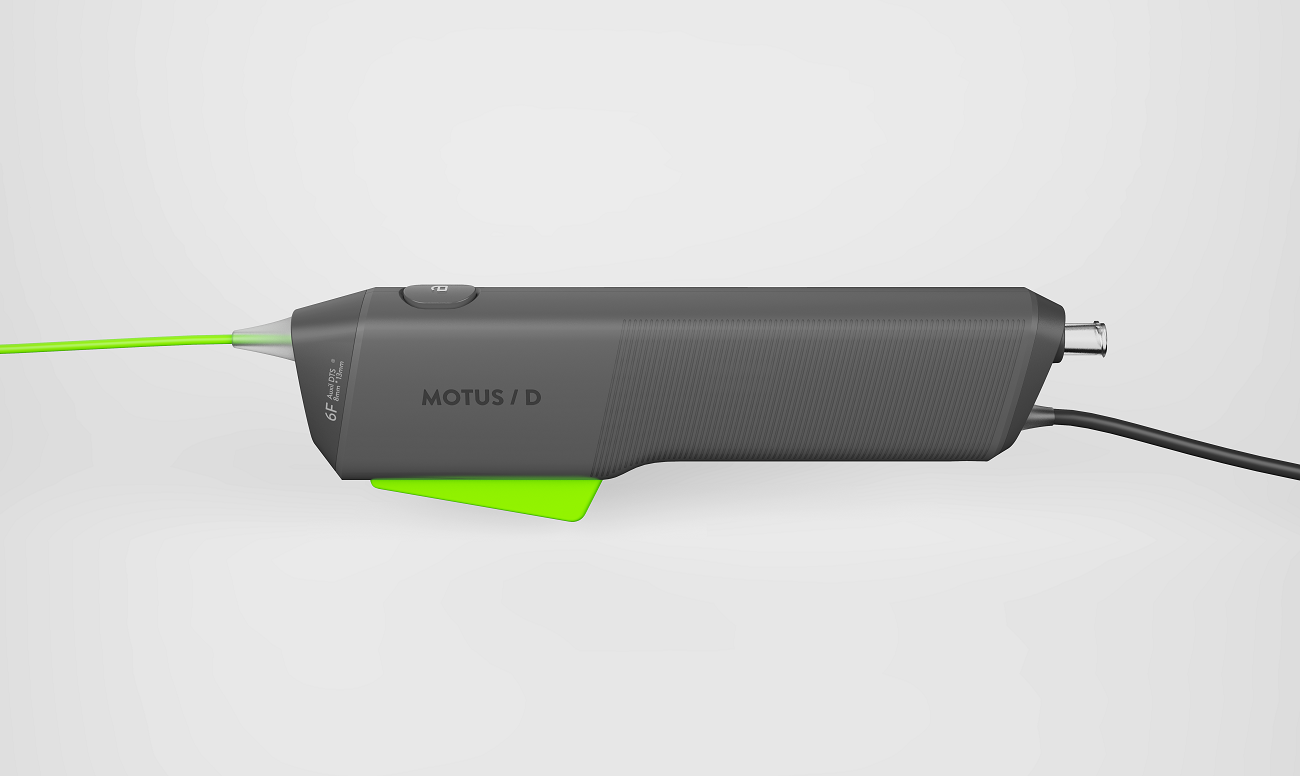
The video gaming industry is one of the biggest in the world, worth an estimated $160bn and expected to reach $300bn by 2025, and a link between gaming and surgical hardware is beginning to emerge. Product design agency Design Partners has been working in both the gaming and healthcare sectors for years, and is now looking into how it can combine its expertise in both areas to improve surgical devices and patient outcomes.
Enter MOTUS/D. Stents are currently inserted into the body mechanically, something that becomes increasingly problematic the deeper into the body they need to be inserted. As locations become more difficult to reach, surgeons have to apply greater force and employ bigger movements, which can cost them a degree of accuracy and precision. The motorised MOTUS/D aims to eliminate this problem, using in-handle electronics to develop a pressure sensitive trigger which allows the surgeon to control the wire steadily and accurately.
Using MOTUS/D, surgeons are able to concentrate more on precision than force, controlling the handle and deciding to slow down or speed up based on on-screen imaging, just like in a video game.
Design Partners creative director Cormac Ó Conaire and healthcare design director Eugene Canavan discuss how this device could help shape the future of the medical device industry.
Chloe Kent: How does Design Partners aim to combine gamification with medical technology?
Cormac Ó Conaire: We’re very interested in how the physical aspects of the devices that medical professionals use can be influenced by gaming. Gamers and surgeons, they share very important qualities – this appreciation of precision and accuracy, visual-spatial skills, depth perception and total immersion in what they do, this kind of unrelenting focus.
How well do you really know your competitors?
Access the most comprehensive Company Profiles on the market, powered by GlobalData. Save hours of research. Gain competitive edge.

Thank you!
Your download email will arrive shortly
Not ready to buy yet? Download a free sample
We are confident about the unique quality of our Company Profiles. However, we want you to make the most beneficial decision for your business, so we offer a free sample that you can download by submitting the below form
By GlobalDataEugene Canavan: In the world of surgical devices, especially delivery devices, what tends to happen is that the surgeons need to go deeper and deeper into the body through increasingly torturous paths. When you add in other factors like drug eluting stents, the force becomes higher and higher. The problems that come with that are that it’s blind navigation. What we’ve been looking at lately is motorising these devices, taking away that physical limitation.
Once I started playing with motorised delivery surgical products, we were struck by how similar the usability of that was to gaming products. There’s a crossover in surgical robotics as well; those controllers for robotic arms are straight out of gaming, basically. There’s a lot of surgical devices that can learn from gaming.
CK: What kind of device is MOTUS/D?
CÓC: It’s a product that we’ve developed taking our expertise from gaming and surgery and combining that. MOTUS/D eliminates the problems Eugene was talking about with inserting stents deeper into the body in difficult-to-reach areas. We’ve taken this concept and started to flesh out the physical design of the handheld surgical device, and then the design and engineering team have turned this into a reality. We’re looking at how the surgeon would hold it, the ergonomics around it, the technology inside of the electronics to enable the trigger to be pressure-sensitive to control the delivery wire steadily and accurately.
It goes further than simply answering a medical need. How the surgeon feels about the device, how they would connect with it and how it would elevate them as professionals, all combine to create this better product experience. Video games is one area, but when you’re talking about physical devices, how do you build immersion into a physical device? We think about engaging the senses, we call it sensory engagement. It’s not about just meeting regulatory requirements and de-risking a product into existence, what we try to do is elevate the surgeon’s experience and the emotional connection they have with what they do.
CK: What clinical studies have you completed to back up the product so far?
EC: We’ve done internal benchtop testing, we’ve created the design. At the moment what we’re doing is deploying stents that are comparable to the existing gold standard. It’s actually tested to a point where, as the industry would call it, it’s proof of principle. It can establish stents as well as the mechanical device, but you don’t have this mechanical limitation. Of course, there are a lot of challenges, like how the feel is then translated back to the surgeon with haptic feedback.
Really, what Design Partners is doing is putting a bit of a challenge out there to the industry, we’re being a little bit disruptive on purpose. We’re putting this out there and saying ‘what if we designed more devices like this?’
CK: When would you hope to see MOTUS/D in a surgeon’s hand?
EC: We hope soon, but what we’re really doing is putting this out there so that it changes the conversation within the industry. We’re publishing it and we’re hoping to inspire some people. MOTUS/D may not be the actual final product, but we’re hoping it will change the conversation and actually get companies thinking about this.



